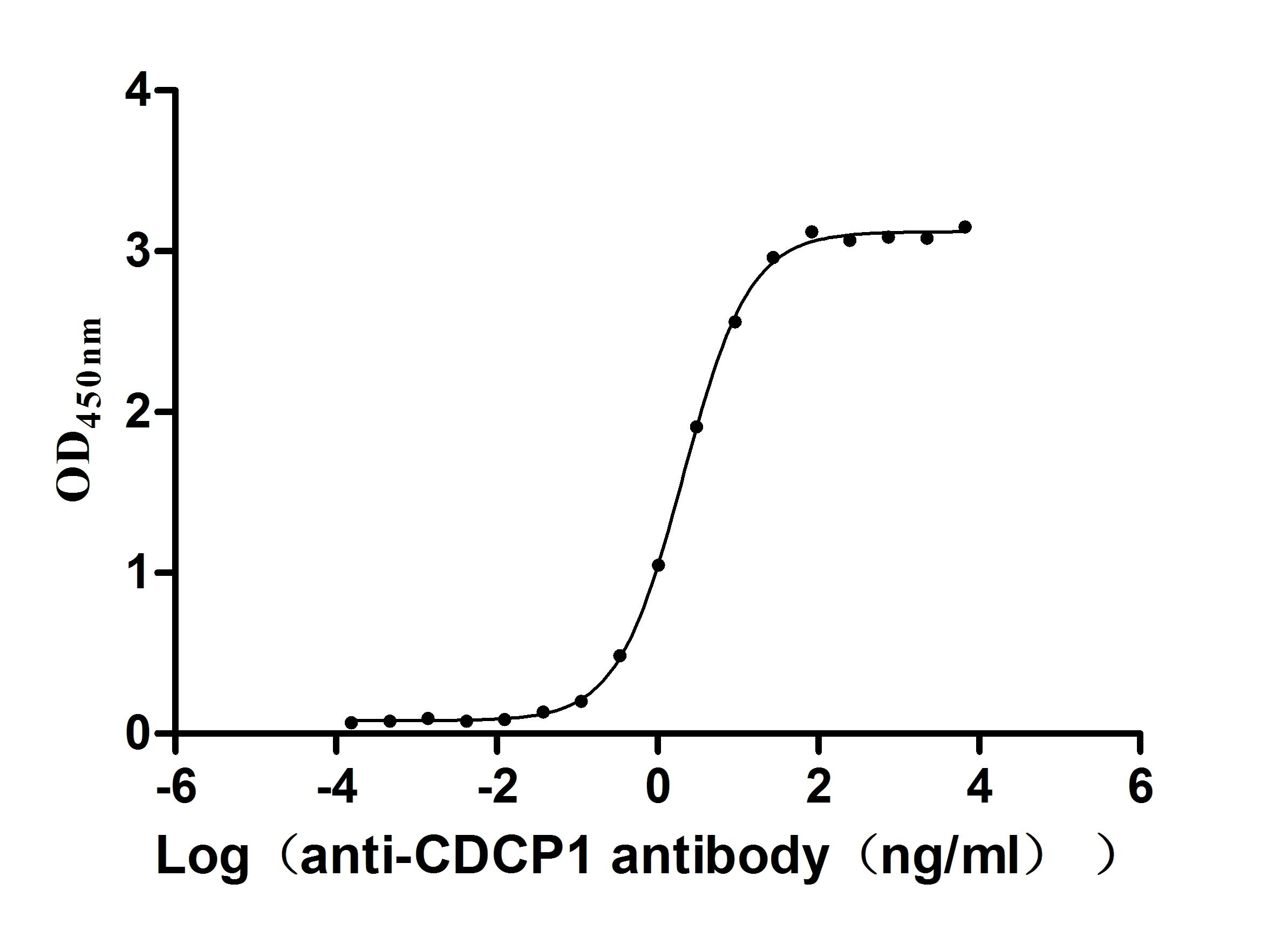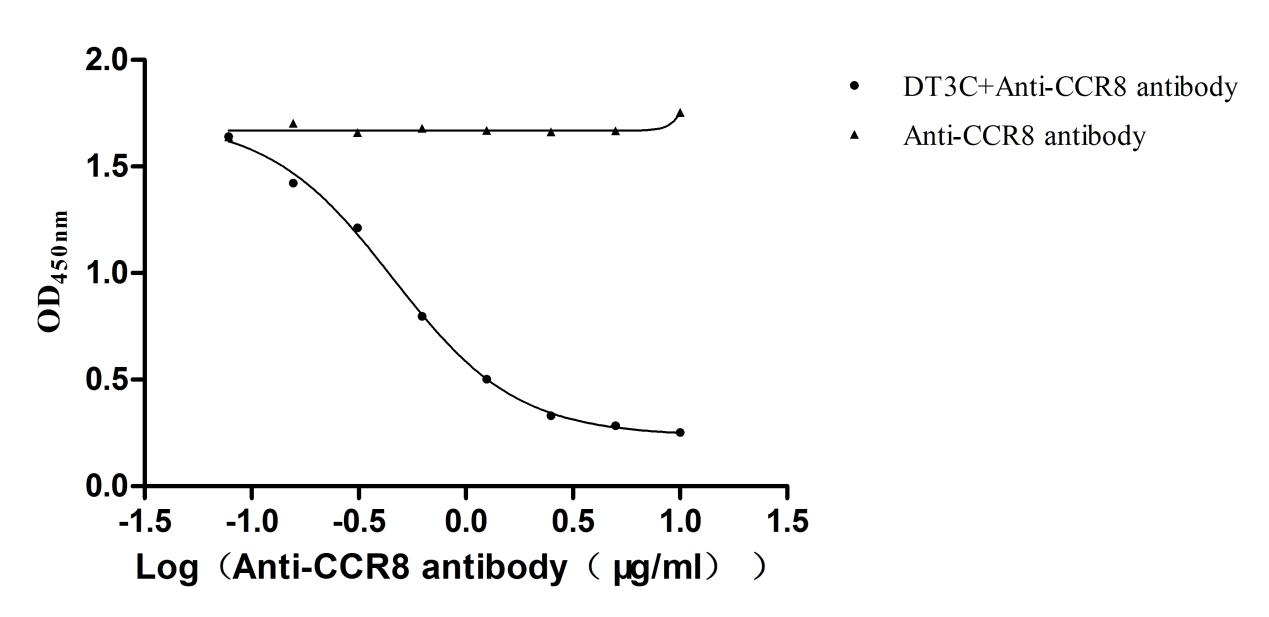Recombinant Human Apolipoprotein D (APOD)
-
货号:CSB-YP001935HU
-
规格:
-
来源:Yeast
-
其他:
-
货号:CSB-EP001935HU
-
规格:
-
来源:E.coli
-
其他:
-
货号:CSB-EP001935HU-B
-
规格:
-
来源:E.coli
-
共轭:Avi-tag Biotinylated
E. coli biotin ligase (BirA) is highly specific in covalently attaching biotin to the 15 amino acid AviTag peptide. This recombinant protein was biotinylated in vivo by AviTag-BirA technology, which method is BriA catalyzes amide linkage between the biotin and the specific lysine of the AviTag.
-
其他:
-
货号:CSB-BP001935HU
-
规格:
-
来源:Baculovirus
-
其他:
-
货号:CSB-MP001935HU
-
规格:
-
来源:Mammalian cell
-
其他:
产品详情
-
纯度:>85% (SDS-PAGE)
-
基因名:APOD
-
Uniprot No.:
-
别名:APO D; Apo-D; ApoD; APOD protein; APOD_HUMAN; Apolipoprotein D; ApolipoproteinD
-
种属:Homo sapiens (Human)
-
蛋白长度:Full length protein
-
表达区域:21-189
-
氨基酸序列QAFHLGKCPN PPVQENFDVN KYLGRWYEIE KIPTTFENGR CIQANYSLME NGKIKVLNQE LRADGTVNQI EGEATPVNLT EPAKLEVKFS WFMPSAPYWI LATDYENYAL VYSCTCIIQL FHVDFAWILA RNPNLPPETV DSLKNILTSN NIDVKKMTVT DQVNCPKLS
-
蛋白标签:Tag type will be determined during the manufacturing process.
The tag type will be determined during production process. If you have specified tag type, please tell us and we will develop the specified tag preferentially. -
产品提供形式:Lyophilized powder
Note: We will preferentially ship the format that we have in stock, however, if you have any special requirement for the format, please remark your requirement when placing the order, we will prepare according to your demand. -
复溶:We recommend that this vial be briefly centrifuged prior to opening to bring the contents to the bottom. Please reconstitute protein in deionized sterile water to a concentration of 0.1-1.0 mg/mL.We recommend to add 5-50% of glycerol (final concentration) and aliquot for long-term storage at -20℃/-80℃. Our default final concentration of glycerol is 50%. Customers could use it as reference.
-
储存条件:Store at -20°C/-80°C upon receipt, aliquoting is necessary for mutiple use. Avoid repeated freeze-thaw cycles.
-
保质期:The shelf life is related to many factors, storage state, buffer ingredients, storage temperature and the stability of the protein itself.
Generally, the shelf life of liquid form is 6 months at -20°C/-80°C. The shelf life of lyophilized form is 12 months at -20°C/-80°C. -
货期:Delivery time may differ from different purchasing way or location, please kindly consult your local distributors for specific delivery time.Note: All of our proteins are default shipped with normal blue ice packs, if you request to ship with dry ice, please communicate with us in advance and extra fees will be charged.
-
注意事项:Repeated freezing and thawing is not recommended. Store working aliquots at 4°C for up to one week.
-
Datasheet :Please contact us to get it.
相关产品
靶点详情
-
功能:APOD occurs in the macromolecular complex with lecithin-cholesterol acyltransferase. It is probably involved in the transport and binding of bilin. Appears to be able to transport a variety of ligands in a number of different contexts.
-
基因功能参考文献:
- Study shows that in myelin maturation ApoD ultimately controls the removal of the sialic-rich hydrophilic glycocalyx, by maintaining functional integrity of lysosomes. A detailed analysis of the mechanism reveals that the proper localization of Neu1 and plasma membrane Neu3, as well as of the membrane-bound Fyn kinase, depend on ApoD. PMID: 29222871
- These results provide additional mechanistic information on the apoD-mediated neuroprotection in neurodegenerative conditions. PMID: 27271124
- This study demonstrated that Apo D is mainly located in glial cells while Apo J expression preferentially occurs in neurons in brain with patient with Alzheimer's Disease. PMID: 27197790
- ApoD expression is likely not a predictor of recurrence in tamoxifen-treated patients. IMPACT: This study eliminates the previously suggested marker ApoD as a predictor of recurrence among tamoxifen-treated women PMID: 28301514
- The high rate of APOD expression in HGPIN and cancer, as well as the absence of its expression in the vast majority of morphologically normal glands allows the use of this protein as an additional marker in the differential diagnosis of prostatic neoplasms. PMID: 27804940
- Our results provide a viable solution to the production of recombinant ApoD protein in lieu of previous obstacles in generating soluble and functional ApoD protein PMID: 26826316
- apoD protein levels are variable across different brain regions. PMID: 26829325
- The data suggest that the presence of Apo D in the nucleus, which some s related with a specific transport, is a consequence of structural and functional alterations during oxidative stress PMID: 25953740
- hepatic steatosis observed in apoD Tg mice is a consequence of increased PPARgamma transcriptional activity by AA leading to increased fatty acid uptake by the liver PMID: 26083030
- The SNP rs7659 within the APOD gene might be related to risk and severity of ischemic stroke in patients. PMID: 25261976
- apoD mediates binding of high density lipoprotein to low density lipoprotein and to growing T24 carcinomas, thereby highlighting the importance of apoD in lipid metabolism. PMID: 25513803
- The internalization of apoD is mediated by basigin. PMID: 25918162
- ApoE is located in the nucleus and on the ApoD promoter in human hepatic and glioblastoma cells lines. PMID: 23715769
- Rs7659, 3' UTR polymorphism of the APOD gene was associated with early onset Alzheimer disease in APOEepsilon4 (-) subgroup. Our results suggest that the variation of the APOD gene modifies the risk for Alzheimer disease. PMID: 23690001
- ApoD mRNA expression is seen in whole endometrium, stromal and epithelial cells in the secretory phase, as well as after hormonal stimulation in vitro. PMID: 23895740
- We propose that strong brainstem expression of Apo D throughout adult life contributes to resistance against neurodegenerative disease and age-related degeneration, possibly by preventing oxidative stress and ensuing lipid peroxidation. PMID: 24167586
- ApoD is marker of initial stages of colorectal cancer progression. PMID: 23296401
- Data suggest that ApoD binds various lyophilic ligands: retinoic acid, retinol, fatty acids, sphingomyelin, and anandamide. ApoD successfully delivers retinoic acid to immature neuronal cell line resulting in neurogenesis (i.e., neurite formation). PMID: 23777559
- Molecular dynamics analysis of apolipoprotein-D-lipid hydroperoxide interactions show the mechanism for selective oxidation of Met-93 PMID: 22479522
- Our findings show that Apo D expression is influenced by age, Braak stage, and sex. PMID: 21429623
- Endothelial cells downregulate apolipoprotein D expression in mural cells through paracrine secretion and Notch3 signaling. PMID: 21705670
- increased JNK1 activation in the apocrine cells from axillary osmidrosis contributes to the increased ApoD expression PMID: 21526344
- A strong relationship with gestational diabetes and APOD in the placenta that may reflect its suggested function in defense mechanisms against oxidative stress. PMID: 19944460
- The decrease in plasma ApoD concentration during pregnancy is an adaptive response aimed at maintaining fetal lipid homeostasis. PMID: 19723339
- Altered levels of apoD may help to understand the nature and possible mechanism of phospholipid membrane pathology in schizophrenia. PMID: 12363390
- Data suggest that the risk of Alzheimer disease among African-Americans may be modified by genetic variation in APOD. PMID: 12497622
- APOD is a senescence-associated gene in normal human oral keratinocytes. PMID: 12837283
- Apolipoprotein D levels are elevated in prefrontal cortex of subjects with Alzheimer's disease, suggesting that it may be related to the cognitive decline observed in AD patients. PMID: 12873803
- ApoD selectively modulates the proliferative response of vascular smooth muscle cells to growth factors by a mechanism related to nuclear translocation of ERK1/2. PMID: 14551159
- In a study comparing brains from Alzheimer's patients and controls, it was found that hippocampal apolipoprotein D level depends on Braak stage and APOE genotype. PMID: 14596852
- ApoD can be expressed or taken up by SMCs and can regulate their motility in response to growth factors. PMID: 15192024
- The -352G allele was associated with a significant 3-fold increase in the risk of early-onset Alzheimer's disease (OR: 2.7; 95% CI: 1.1-6.5). The -352G containing haplotypes were more common for early-onset Alzheimer's disease cases. PMID: 15316799
- Elevated apoD in AD brain may influence Abeta aggregation, or facilitate phagocytosis and transport of Abeta fibrils from plaques to cerebral vasculature. PMID: 15916898
- study of the presence of apo D in the substantia nigra of control and Parkinson disease (PD) subjects; dopaminergic neurons were not immunoreactive for apo D but surrounding glial cells showed immunostaining for apo D and signal increases in PD cases PMID: 16437381
- Apo D differentiates superficial acral fibromyxoma from dermatofibrosarcoma protuberans. PMID: 17885669
- ApoD positive tumors had both a significantly shorter relapse-free survival (all locations) and a decreased breast cancer-specific survival. PMID: 18330697
- These observations, together with its transcriptional up-regulation in the brain upon oxidative insult, identify ApoD as an acute response protein with a protective and therefore beneficial function mediated by the control of peroxidated lipids. PMID: 18419796
- ApoD and its orthologs play an evolutionarily conserved role in response to stress, possibly managing or preventing lipid peroxidation. PMID: 18458334
- Logistic analysis revealed that both APOD rs5952 C and rs1568566 T alleles increase the risk of sporadic Alzheimer's disease. The rs5952T-rs1568566C haplotype showed lower risk. PMID: 18671953
- Role for apoD in regulation of inflammation. It may protect from HCoV-OC43-induced encephalitis, most likely through phospholipase A2 signaling pathways. PMID: 18842892
- study demonstrated that Apo D was highly expressed in the mRNA and protein levels in human failing hearts compared with non-failing hearts PMID: 18979643
- Variations in the levels and/or sites of apoD expression influence the lipid and glucose metabolism, consolidating apoD as a target for insulin-resistance-related disorders. PMID: 19176353
- Apolipoprotein D (APOD) and two further transcripts were significantly upregulated by dihydrotestosterone (DHT) in scrotum fibroblasts PMID: 19330472
- apoD expression is increased throughout life in the human prefrontal cortex PMID: 19519777
显示更多
收起更多
-
亚细胞定位:Secreted.
-
蛋白家族:Calycin superfamily, Lipocalin family
-
组织特异性:Expressed in liver, intestine, pancreas, kidney, placenta, adrenal, spleen, fetal brain tissue and tears.
-
数据库链接:
HGNC: 612
OMIM: 107740
KEGG: hsa:347
STRING: 9606.ENSP00000345179
UniGene: Hs.522555
Most popular with customers
-
Recombinant Human Tumor necrosis factor ligand superfamily member 18 (TNFSF18), partial (Active)
Express system: Mammalian cell
Species: Homo sapiens (Human)
-
Recombinant Human Desmoglein-2 (DSG2), partial (Active)
Express system: Mammalian cell
Species: Homo sapiens (Human)
-
Recombinant Macaca fascicularis CUB domain containing protein 1 (CDCP1), partial (Active)
Express system: Mammalian cell
Species: Macaca fascicularis (Crab-eating macaque) (Cynomolgus monkey)
-
Recombinant Human Myosin regulatory light chain 12B(MYL12B) (Active)
Express system: E.coli
Species: Homo sapiens (Human)
-
Recombinant Human CD70 antigen (CD70), partial (Active)
Express system: Mammalian cell
Species: Homo sapiens (Human)
-
Recombinant Human Interleukin-1 receptor accessory protein (IL1RAP), partial (Active)
Express system: Mammalian cell
Species: Homo sapiens (Human)
-
Recombinant DT3C (Diphtheria toxin & spg 3C domain) for Antibody Internalization Assay (Active)
Express system: E.coli
Species: N/A



















